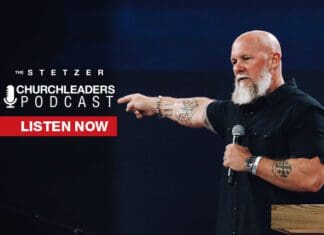Have you ever experienced church hurt? As a counselor, I’ve seen the various wounds that people experience from unhealthy leaders while attending church. Here are some examples of church hurt:
• A single mom whose church promised to stand by her, then disappeared after she got a divorce from her abusive husband
• A kind-hearted woman who was told that she would “burn in hell” if she made friends with the “wrong” kind of people
• A young couple forced out of their church after they stood up to a narcissistic pastor
• A man who opened up about his struggles only to be told his depression meant he lacked real faith
I’m a psychologist, and I’m also a follower of Jesus. I believe faith and psychology can work hand-in-hand. So, one of the problems that irks me the most is when a church leader in a position of authority misrepresents or distorts someone’s view of God by acting abusively.
Church hurt can cut you to the core. Much like our parents, we see church leaders as having authority. We look to them to lead us and shepherd us well. We trust them with our hearts and with our areas of vulnerability.
When the people whom we trust manipulate, shame, reject, or use others for selfish gain, the effects are extremely painful and confusing. It hits us where we are most tender, causing us to question both God and our own sense of worth. In some cases, the pain can cause to wonder, “If church can hurt me so deeply, then what does that say about God? Who is God anyway? Can He really be trusted?”
In addition, church hurt can damage how you think about yourself. Rationally, you might know the pain is not your fault. But, parts of you can still wonder if you did something wrong. Toxic shame enters your mind, and you might start wondering, “If that church represents God, then how could they be wrong? What if I am the problem? What if I deserved what I got?”
Church hurt is soul crushing.
I’ll be honest. The process of healing from church hurt is not easy. It can be hard to face the pain. It can be hard to disentangle the God who loves you from the misrepresentation of God by an unhealthy leader. Understandably, many people get angry and stay bitter. Others decide to leave the church all together.
But, I believe there is another way through. I have walked this path with countless individuals, and it is some of the most gratifying work that I do.
If you’re struggling with pain of church hurt or if a church misrepresented God to you through toxic, abusive actions or words, please know you are not alone. You are still in the center of God’s love AND God’s justice. God hates church hurt, too (See Matthew 18:6).
Here are four steps that I recommend to heal from church hurt:
4 Steps to Heal from Church Hurt
Step 1. Define Church Hurt as Abuse
Church leaders hold power. But, great power includes great responsibility. If someone misuses their power, the result is defined as “abuse,” which means to act in a manner to cause “bad effect or for a bad purpose; misuse” (Oxford Languages Dictionary). Church hurt stems from experiencing someone else abusing their power.
A church has power to gather, encourage, and heal God’s beloved people. On the positive side, church can help you:
- Encourage yourself and others (1 Thessalonians 5:11; Hebrews 10:25)
- Give thanks and marvel at God’s wonders (Colossians 3:16)
- Grow in humble, honest self-awareness (James 4:8)
- Pray with other people (Acts 2:42)
- Grow in wisdom and knowledge of God (Ephesians 3:10)
- Care for those who are most vulnerable (James 1:27)
In contrast, when a church leader abuses his or her power, it has the opposite effect, such as causing:
- Discouragement and disappointment in yourself and others
- Feelings of anger, confusion, and bitterness toward God
- Toxic movement toward rigid self-denial and self-hatred
- Bypassing or denial of pain and emotions (vs. bringing them to God honestly)
- False ideas about God (vs. the God Jesus embodied)
- Further wounds on the most vulnerable
The first step toward healing, then, is to name the church hurt as “abuse.” Here are some examples:
- He attacked the young girl that God made. That was an abuse of church power.
- She taught me I wasn’t worthy of God’s love. That was an abuse of church power.
- They told my secrets to others and called it prayer. That was an abuse of church power.
- He told me that my abusive husband’s behavior was my fault. That was an abuse of church power.
- She said my depression was evidence that I lacked faith. That was an abuse of church power.
The purpose of this step is not to harbor resentment. Instead, the initial process of healing hinges upon you naming the wrong behavior that occurred.
Step 2. Separate the Church Hurt from God’s Character
Some aspects of God’s character are crystal clear throughout the Bible. If you feel busted up or beaten on by a church community, it is important to step back for a moment and remind yourself who God is apart from the hurtful actions. For instance:
- God loves justice, mercy, and humility. (Micah 6:8)
- God is for the poor in spirit, the grief-stricken, the humble, the broken-hearted, and the peacemakers (Matthew 5:1-12)
- God stands against the proud, and for the humble (James 4:6)
- God is love (1 John 4:7)
- God’s presence shows up as love, joy, peace, patience, kindness, goodness, faithfulness, gentleness and self-control (Galatians 5:22-23)
You might also look to the life of Jesus and notice how he interacted with various types of people. He was clear about his stance toward individuals in these three categories:
Abusers of Power:
Jesus gave his harshest words to religious leaders who judged, criticized, oppressed, and left people out. These folks created cliques and always attempted to maintain their power. If you’re not convinced that Jesus was harsh with unhealthy religious leaders, read these passages: Matthew 23, Mark 9:42, Luke 11:43–44.
The Sufferers:
Jesus drew close to people who were hurting, wounded, sick, and suffering. He didn’t blame them for their suffering, nor did he marginalize them. Instead, he encouraged them, helped them, and treated them with respect. Read some of the life-giving stories of how Jesus interacted with suffering in these passages: Luke 17:12–16, John 9:6–7.
The Marginalized:
Jesus also showed a soft spot for those on the outs, such as “sinners,” rebels, and the people who others tended to despise. For example, do you remember the woman who got caught in adultery? Jesus purposefully intervened to protect her. In another story, Jesus first revealed his true identity to a woman four times divorced. She was from Samaria, a place equivalent to “the wrong side of the tracks.” Read more stories of Jesus siding with marginalized individuals in these passages: Mark 2:15–16, Luke 7:36–39, John 4:25, 26.
As you identify God’s desire to help hurting people, you will find a powerful ally. God is on the side of those who have suffered, not on the side of those who abuse their power.
Step 3. Recover Your Power
If you’ve experienced church hurt, it can cause you to feel helpless and alone. In order to reclaim your power, you need to set boundaries with those responsible for the pain. Then, you also need to heal the agony inside your own soul. But, in order to heal, you’ll need the help of safe people. Here are some ways to start that process:
Prioritize your own emotional recovery first.
It’s not your job to have empathy for those in power who hurt you. There might be a time for forgiveness and/or reconciliation way down the road. But, it is far more important that you separate yourself out from the harm and restore the parts of yourself that were wounded.
Seek support outside of the church.
If your church culture is toxic, it’s crucial to get a healthy perspective from someone who is outside that environment. For instance, contact a counselor or trusted adviser who can help you stay clear and grounded as you name the church hurt and find your way to solid ground.
Wait to communicate until you have a strong support network.
Once you are clear about the nature of your church hurt, you might try communicating boundaries with the leaders of a church community. But, please do NOT take this step alone.
It is wise to enlist help to ensure that you don’t get pulled back up into a web of toxicity and experience more harm. If you do decide to confront a hurtful leader, make sure you have support. Then, pay close attention to the response. You will quickly learn if that person is messy-but-loving, or someone who is truly toxic. If it’s the latter, it is probably time to find a new church community.
Step 4. Reclaim Your Spiritual Practices
As you begin to reclaim your personal power, you can also reclaim some spiritual practices. But, just like any physical wound, certain situations may rekindle more pain. With emotional pain, there may be specific words and practices that seem normal to everyone else, such as prayer or listening to a sermon, but they bring up uncomfortable, painful feelings within you. That’s because those practices got twisted due to the leader’s abusive actions.
For example, if someone betrayed your trust while claiming to “pray” for you, their actions could make the idea of prayer feel uncomfortable. Likewise, certain Bible verses may have been used to manipulate you, which might bring up painful feelings when you hear those passages again.
In those situations, notice the feelings and be gentle with your reaction. It doesn’t mean that you don’t love God. In fact, it’s the opposite! You are developing important skills to help you discern when to trust versus when to sound the danger alarm. You’re learning how to discover Jesus apart from the leaders who misrepresented him. You can reclaim your spiritual practices from the ones who stole them from you.
Turn the negative into a positive by redefining old harmful words into new terms. For example, think of “prayer” as just a loving way to talk with God. You could even keep your eyes open and look at something beautiful or comforting that reminds you of God’s love. Talk to God out loud, listen to soothing music, walk with a friend, or write in a journal. When several people are gathered in meaningful, honest connection, God is there with them.
Above all, God is against “church hurt.”
God desires to meet you in the tender places and provide healing. He doesn’t force, control, or manipulate. He wants to restore the goodness in your life that was taken away by an abusive leader.
Begin your healing process by defining church hurt as abuse, separate the hurtful behavior from God’s character, recover your personal power, and reclaim your spiritual practices. You are never alone in the miraculous power of God’s love.
This article originally appeared here.























